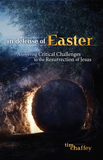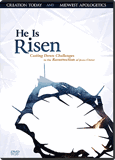
Biblical and Extra-Biblical Evidences
Tim Chaffey, AiG–US, addresses many more evidences that Jesus rose from the dead, which are either described in Scripture or derived from it.
Our previous article on the Resurrection of Jesus discussed the “many infallible proofs
” (Acts 1:3) of this event. Today, we will address many of the other evidences that Jesus rose from the dead, which are either described in Scripture or derived from it. We will also survey what have been called the minimal facts to show what would happen if we were to use the critics’ own criteria.
Evidences that Jesus Rose
The Bible describes several pieces of evidence that are consistent with the belief that Jesus rose from the dead. Some of these evidences are explicitly stated in the text, while others are based on strong inferences drawn from the text. As such, some of these points are more convincing than others, but taken together with the “infallible proofs,” there is only one reasonable conclusion: Jesus rose physically from the dead.
Conversion of James
The man who wrote the Epistle of James was the half-brother of Jesus, the son of Mary and Joseph, and an early leader of the church in Jerusalem.1 For whatever reason, James did not believe in Jesus as the Messiah prior to the Resurrection. In fact, none of His brothers believed in Him early on (John 7:5), and even tried to prevent Him from speaking, thinking He was out of His mind (Mark 3:20–21, NET).2 However, just several weeks after the Crucifixion they were counted among His followers (Acts 1:14). And by the time of the “Jerusalem Council” in Acts 15, James was one of the leading figures at the church in Jerusalem. Paul seems to imply this as well in Galatians 1:18–19 and 2:9. Several early sources reveal that James was eventually martyred for his faith.3
What could compel a man who had grown up with Jesus to suddenly change his mind about his older brother? James likely remained in his unbelief until after Christ’s death. After all, while He was on the Cross, Jesus entrusted the care of His mother to the Apostle John (John 19:26–27). If one of his brothers had been a believer at this point, it would have been their responsibility to care for Mary. Although Scripture does not describe the conversion of James for us, it does provide the most likely cause for his drastic change of heart. Upon telling his readers that Jesus appeared to over 500 people at once, Paul wrote, “After that He was seen by James
” (1 Corinthians 15:7).
While it is possible that James converted to the faith based on reports of his brother’s Resurrection, it is far more likely that he became a believer when Jesus appeared to him. Whatever it was that triggered his conversion, James believed in the Resurrection so strongly that he was willing to die for his faith.
Conversion of Saul/Paul
The Apostle Paul (also called Saul) is responsible for penning at least 13 books of the New Testament and is arguably the most influential Christian ever. But he was not always a devout follower of Christ. We are first introduced to him observing the stoning of Stephen (Acts 7:58). A few verses later we read that Saul “made havoc of the church, entering every house, and dragging off men and women, committing them to prison
” (Acts 8:3). He would later tell an angry crowd in Jerusalem that he persecuted Christians “to the death, binding and delivering into prisons both men and women
” (Acts 22:4). He wrote that he “persecuted the church of God beyond measure and tried to destroy it
” (Galatians 1:13).
From a human perspective, this is not the person we would select to carry the gospel message throughout the Roman Empire, but God had other plans for Paul. Acts 9 opens with the following words: “Then Saul, still breathing threats and murder against the disciples of the Lord, went to the high priest and asked letters from him to the synagogues of Damascus, so that if he found any who were of the Way, whether men or women, he might bring them bound to Jerusalem
” (Acts 9:1–2). Paul was the church’s greatest persecutor, but he was about to see the Light (pun intended).
As Paul approached Damascus, Jesus appeared to him and asked, “Saul, Saul, why are you persecuting Me?
” (Acts 9:4). Upon seeing the risen Savior, Saul converted to the Christian faith and tirelessly preached the gospel—Christ’s death for sins, burial, and Resurrection—until his martyrdom many years later. The apostle described some of the trials he endured for Christ:
. . . in labors more abundant, in stripes above measure, in prisons more frequently, in deaths often. From the Jews five times I received forty stripes minus one. Three times I was beaten with rods; once I was stoned; three times I was shipwrecked; a night and a day I have been in the deep; in journeys often, in perils of waters, in perils of robbers, in perils of my own countrymen, in perils of the Gentiles, in perils in the city, in perils in the wilderness, in perils in the sea, in perils among false brethren, in weariness and toil, in sleeplessness often, in hunger and thirst, in fastings often, in cold and nakedness … (2 Corinthians 11:23–27)
What could possibly explain such a drastic change of heart? This was not a foolish man who could be swayed by poor argumentation, nor was he prone to changing his views based on shifting public opinion. Paul was a scholar and a well-respected Pharisee. But he was suddenly transformed into a fearless evangelist and church planter who suffered greatly for preaching the gospel before Jews and Gentiles, kings, civil leaders, and commoners.
The only reasonable explanation for this change of heart is precisely what Paul said it was: “Then last of all [Jesus] was seen by me also
” (1 Corinthians 15:8). Paul was so committed to serving Christ that he was beheaded in Rome during Nero’s reign.4 His treatise on the absolute necessity of the Resurrection for the Christian faith in 1 Corinthians 15 demonstrates this former Pharisee’s undying commitment to the gospel of Christ.
The Change in the Disciples
James and Paul were not the only people to undergo drastic changes. On the night Jesus was arrested, His disciples fled in fear (Mark 14:50). As far as we know, of the eleven disciples only John had the courage to remain close enough to Jesus to observe some of the proceedings up to and including the Crucifixion (John 18:15; 19:26). Peter attempted to stay with Jesus but ended up denying Christ several times before fleeing in shame (Matthew 26:69–75).
Less than two months later, Peter stood in front of thousands of Jews in Jerusalem and boldly delivered one of the least “seeker-sensitive” messages of all time. He declared that they had “taken by lawless hands, [had] crucified, and put to death
” their Messiah, but “God raised [Him] up
” (Acts 2:23). It’s difficult to imagine how offensive Peter’s words would have been to such a crowd. These people had been longing for the Messiah to come, but when He came, they failed to recognize Him (Luke 19:41–44; Acts 3:17; 1 Corinthians 2:8). Instead of welcoming Him with open arms, they had delivered Him to be executed by one of the most brutal means imaginable—crucifixion.
But Peter and the disciples weren’t done. After healing a crippled man in the name of Jesus, Peter soon spoke to another large crowd of Jews in the temple. He unflinchingly proclaimed, “But you denied the Holy One and the Just, and asked for a murderer to be granted to you, and killed the Prince of life, whom God raised from the dead, of which we are witnesses
” (Acts 3:14–15).
The disciples were arrested and on the next day they stood before “their rulers, elders, and scribes, as well as Annas the high priest, [and] Caiaphas…
” (Acts 4:5–6). What was Peter’s message? “Let it be known to you all, and to the people of Israel, that by the name of Jesus Christ of Nazareth, whom you crucified, whom God raised from the dead, by Him this man stands here before you whole… Nor is there salvation in any other, for there is no other name under heaven given among men by which we must be saved
” (Acts 4:10, 12). The disciples were commanded by the authorities to stop preaching in the name of Jesus (Acts 4:18), but they replied, “Whether it is right in the sight of God to listen to you more than to God, you judge. For we cannot but speak the things which we have seen and heard
” (Acts 4:19–20). Upon their release and following a prayer for boldness, we are told, “And with great power the apostles gave witness to the resurrection of the Lord Jesus
” (Acts 4:33).
In the next chapter of Acts, the disciples were arrested and imprisoned, miraculously freed by an angel, and taken into custody again. They refused to stop preaching and told the council, “We ought to obey God rather than men. The God of our fathers raised up Jesus whom you murdered by hanging on a tree
” (Acts 5:30).
According to church tradition, all of the disciples except for John suffered a martyr’s death because they continually preached what they had seen and heard: Jesus was crucified, but now He was alive again because God had raised Him from the dead. James, the brother of John, was killed by Herod with the sword (Acts 12:2). An early church tradition records that Peter was crucified upside down, which is consistent with what Jesus told him in John 21:18–19. Early church tradition also holds that the other disciples suffered martyrdom in various manners: spearing, flaying, crucifixion, the sword, and boiling oil.
The book of Acts makes it pretty clear why these men who fled in fear on the night Jesus was arrested were willing to die for Him. They were filled with the Spirit (Acts 2:4; 4:8), and they knew that even though Jesus had died, He was alive and well. They had seen Him with their own eyes and touched Him with their own hands (1 John 1:1–3), and only death could silence them.
Scoffers have attempted to downplay this remarkable proof of the Resurrection by claiming that many people are willing to die for a cause. For example, some Muslims are willing to blow themselves up to kill Jews. That’s true, but it misses the point. The Muslims who do this sort of thing sincerely believe in their cause, but they do not know if it’s true. The disciples were in a position to know whether or not Jesus was raised from the dead. It simply is not plausible to suggest that each of these men would face continual persecution and horrifying deaths for something they knew to be a lie. After all, liars don’t make good martyrs. And in contrast to suicide bombers, the disciples didn’t kill others in their respective martyrdoms. And they didn’t use violence to force people to convert to Christianity. In fact, they did no harm to anyone, but loved their enemies and willingly accepted persecution from them for the sake of the gospel.5
The Empty Tomb
Jesus was buried in the tomb of a council member from Arimathea named Joseph (John 19:38–42). All four Gospels testify to this fact. The tomb was guarded by Roman soldiers, and a Roman seal was affixed to it (Matthew 27:62–66). If Jesus was bodily resurrected from the dead, then we would expect that His body would not remain in the tomb. Of course, that’s precisely what was discovered on the Sunday morning after the Crucifixion—His body was gone and only the burial cloths remained.
As we will see in upcoming articles, the fact that the tomb was empty has led to numerous imaginative alternative views. If the Lord’s body was still in the tomb on the Day of Pentecost when Peter preached in Jerusalem, the Jewish leaders could have grabbed Peter, taken him to the tomb, and said, “Look, there’s Jesus. He didn’t rise from the dead. Now stop lying to everyone about it.” Yet, there is not a single ancient record of this sort. Instead, the Jewish leaders who opposed Christianity invented the incredible idea that the disciples stole the body to explain away the empty tomb (Matthew 28:11–15).6
The fact that the opponents of the early Christians acknowledged the empty tomb lends authenticity to the accounts, since a person’s enemies are unlikely to help him make his case. This is known as the principle of enemy attestation or the testimony of a hostile witness. “If opponents of the eyewitnesses admit certain facts the eyewitnesses say are true, then those facts probably are true (for example, if your mother says you are brave, that might be true; but it’s probably more credible if your archenemy says the same thing).”7
The Existence of the Church
As noted in the first article of the series, Schaff stated, “The Christian church rests on the resurrection of its Founder. Without this fact the church could never have been born, or if born, it would soon have died a natural death.”8 After an exhaustive study of early Christian beliefs about the Resurrection, N.T. Wright wrote, “Christianity is inexplicable apart from the assumption that virtually all early Christians … did indeed believe that Jesus of Nazareth had been raised bodily from the dead.”9
Due to the remarkable circumstances in first-century Jerusalem, Christianity would have never been able to get started if Jesus had not risen from the dead. Recall that the Resurrection of Jesus was central to the disciples’ preaching. Even if they had the courage to preach without having seen the risen Lord, what message would they have proclaimed? They certainly could not repeatedly claim to have been eyewitnesses of His Resurrection, as they did (Acts 2:32; 3:15; 5:32; 10:39; 13:31). Without this bold proclamation of the Resurrection, and if His body was rotting in the grave, people would not be converted and the memory of Jesus and His disciples would quickly fade. In fact, it may be safely said that if Jesus did not rise from the dead, very few people living today, if any, would have ever heard of Him.10
Undivided Testimony of New Testament
As could be expected, the New Testament writers were undivided in their proclamation that Jesus rose from the dead. Space does not permit an exhaustive treatment of the subject here, but consider that the Resurrection is explicitly mentioned in every New Testament book except for the short letters of Philemon, James, 2 Peter, 2 John, 3 John, and Jude. Yet even these letters presume the truth of the Resurrection since Jesus is portrayed as living and active. So from the penning of the earliest New Testament book to the final one, the Resurrection of Jesus is consistently viewed as central to Christian teaching.
Principle of Embarrassment
A key idea used by historians in weighing the historical validity of alleged events has been called the principle of embarrassment. That is, if the writer included details that would seem to hurt his position, then those details are likely true, since one would not readily undercut his own beliefs with certain data that could just as easily be left unreported.11 Applied to the topic at hand, this principle does not directly relate to the Resurrection, but it does relate indirectly since it provides multiple clues that the eyewitness accounts are authentic.
The Bible includes numerous embarrassing details about its leading figures. For example, David was an adulterer and murderer (2 Samuel 11). Peter was accused of being a mouthpiece of Satan by Jesus when Peter denied that Jesus would be killed in Jerusalem and rise again (Matthew 16:23). Later, despite his promises to the contrary, Peter denied Jesus several times (Luke 22:31–35, 54–62 ). When it comes to the Resurrection accounts in the Gospels, the writers included some embarrassing details that actually afford credibility to their extraordinary claim that Jesus rose from the dead.
If the disciples were inventing Christianity, as has been alleged by some critics and skeptics, then surely they could have made up a more respectable story. They could have claimed that the first witnesses of the empty tomb and the risen Christ were respected men like Nicodemus, Joseph of Arimathea, and perhaps some other members of the Sanhedrin. Maybe they could have said that Jesus appeared to Herod, Pilate, or even the emperor himself. That would be impressive. But what does Scripture tell us about the first witnesses of these things? They were women—at least five of them traveled to the tomb early on Easter morning (Luke 24:10). Given that a woman’s testimony was not highly valued in that patriarchal society,12 it would make no sense for the writers to include this detail if they were attempting to gain a following—unless it was true.
This information is even more embarrassing when we consider who the very first eyewitness was. Who in their right mind would ever make up the idea that Mary Magdalene was the first person to see the risen Savior? By this time Mary was surely a devoted follower of Christ, but she would have virtually zero credibility with anyone outside of the disciples’ circle, and even they didn’t initially believe her report (Luke 24:11). After all, this was a woman “out of whom had come seven demons
” (Luke 8:2).13 That the biblical writers assign Mary Magdalene as the first eyewitness of the resurrected Christ lends strong support for the truthfulness of the account.
The Nazareth Inscription
An interesting archaeological discovery lends early support to the biblical accounts of the Resurrection. The Nazareth Inscription is a marble tablet with Greek writing that has been dated to approximately AD 41. The inscription is likely an abbreviated form of an edict (called a rescript) from Emperor Claudius.
The wording of this particular find indicates that the message of the Resurrection, or at least the Jewish response to it, had been brought to the emperor’s attention within about ten years of the event. In just fourteen brief lines this rescript explains a new law carrying capital punishment for anyone who would move a body from graves or tombs to another place with wicked intent. That is, no one was permitted to move an entombed body for fraudulent reasons.
Why is this so intriguing? Think about the response of the Jewish leaders to the Resurrection reports. They bribed the Roman soldiers to say, “His disciples came at night and stole Him away while we slept
” (Matthew 28:13). Why would the Roman emperor issue an edict forbidding the moving of a body with fraudulent intent? Sure, there were grave robbers at that time, but grave robbers weren’t interested in stealing bodies—they wanted the valuables occasionally buried with the body. Interestingly enough, there is no mention of valuables in the edict, but there is a comment forbidding the moving of sepulcher-sealing stones. These types of stones were only used in Israel, so the wording of this edict pinpoints the reason for its issuance. Something had happened in Israel concerning the reported moving of a body that had caused enough ripples throughout the empire to merit the attention of the emperor.
The Nazareth Inscription does not prove that Jesus rose from the dead, but it is consistent with the biblical accounts. It also gives extra-biblical testimony to the growing impact of the church and its central message of the Resurrection soon after Christ’s death. For more details on this fascinating discovery, along with a full translation of its inscription, please see “The Nazareth Inscription: Proof of the Resurrection of Christ?”
Subjective Evidences
My favorite song as a young boy mentions a remarkable, though subjective evidence that Jesus is alive today. The chorus of “He Lives” closes with the words, “You ask me how I know He lives, He lives within my heart.” This may sound strange to an unbeliever, but Christians can testify to significant, positive life-change as a result of trusting in the risen Christ. People from every nation, from all walks of life, all levels of age or education or material prosperity, all religious backgrounds, and all kinds of moral or immoral lifestyles can testify to a radical change of values, priorities, relationships, and purpose in life as a result of trusting in Jesus Christ as Savior and Lord. Drunks, violent men, prostitutes, addicts, and filthy perverts have found victory from sin through the Lord Jesus Christ. The Bible explains that by His life-giving Spirit Jesus dwells in the hearts of believers through faith (Ephesians 3:17) to gradually transform their lives to be like Christ (Romans 12:2; 2 Corinthians 3:18; 5:17; Ephesians 2:8–10).
Again, this evidence is subjective, and I wouldn’t expect anyone to start believing in the Resurrection based solely on someone’s personal experience. But changed lives are exactly what we would expect if the one who claimed to forgive sin and give eternal life in relationship with God really did rise from the dead. Conversely, if Jesus didn’t rise from the dead, it is very difficult to explain so many changed lives down through the centuries.
Like James and Paul, other former skeptics have been persuaded that Christianity is true based largely on their attempts to disprove the faith, particularly the Resurrection. Some of the most popular Christian apologists, such as Josh McDowell, Lee Strobel, and C.S. Lewis,14 have testified that their attempts to disprove the Resurrection of Jesus were integral to their conversion.
While God is the only one who can supernaturally change a person’s heart, He often uses the evidences of the Resurrection to remove intellectual objections to the Christian faith. John Whitcomb explained that in the account of Jesus raising Lazarus from the dead, it was God who did the supernatural work (raising Lazarus), but He commanded people to move the sepulcher-sealing stone (John 11:39) and unwrap Lazarus (v. 46). Many of the Jews believed in Jesus when they saw this incredible miracle (John 11:45), and the chief priests “plotted to put Lazarus to death also, because on account of him many of the Jews went away and believed in Jesus
” (John 12:10–11). In a sense, that’s how these evidences for the Resurrection of Christ can be used. Figuratively, we can roll away the stones of objections so that people can see the risen Lord.
Five Key Evidences
The Bible is the Word of God, so it is accurate in all it affirms. Since it tells us Jesus rose from the dead, we can have complete confidence that He did. What many people fail to recognize is that even when we use the critics’ and skeptics’ own criteria, the most reasonable conclusion is the same: Jesus rose from the dead. That is, even if we did not presume biblical authority and treated the New Testament as unbelieving historians do, the bodily Resurrection of Jesus is the only explanation that matches all the accepted facts. One point will become rather obvious throughout this study: these people simply have an anti-supernatural bias, or more accurately, an anti-Christian bias. Thus, they have developed absurd positions in efforts to explain away the only reasonable conclusion that can be derived from the facts. So what are these facts?
Since 1975, Resurrection expert Dr. Gary Habermas has catalogued over 3,400 academic works on the fate of Jesus, from conservative, critical, and skeptical scholars in English, German, and French. A skeptic may be tempted to accuse Habermas of only using material from scholars in his own camp, but his research has actually been skewed to favor the most skeptical positions.
I endeavored to be more than fair to all the positions. In fact, if anything, I erred in the direction of cataloguing the most radical positions, since this was the only classification where I included even those authors who did not have specialized scholarly credentials or peer-reviewed publications. It is this group, too, that often tends to doubt or deny that Jesus ever existed. Yet, given that I counted many sources in this category, this means that my study is skewed in the skeptical direction far more than if I had stayed strictly with my requirement of citing only those with scholarly credentials. Still, I included these positions quite liberally, even when the wide majority of mainline scholars, “liberals” included, rarely even footnoted this material. Of course, this practice would also skew the numbers who proposed naturalistic theories of the resurrection, to which I particularly gravitated.15
From this research Habermas has been able to show that of the 3,400 works studied, the majority of writers accept the following 12 events as historical fact:16
- Jesus died by crucifixion.
- Jesus was buried.
- His death caused the disciples to despair and lose hope, believing that his life was ended.
- The tomb was empty a few days later.
- The disciples had experiences that they believed were literal appearances of the risen Jesus.
- The disciples were transformed from doubters who were afraid to identify themselves with Jesus to bold proclaimers of His death and Resurrection.
- This message was the center of preaching in the early church.
- This message was especially proclaimed in Jerusalem, where Jesus died and was buried shortly before.
- The church was born in Jerusalem and grew rapidly.
- Orthodox Jews who believed in Jesus made Sunday their primary day of worship.
- James, the half-brother of Jesus, converted to the faith when he saw what he believed was the resurrected Jesus.
- Paul was converted to the faith after his experience which he believed was with the risen Jesus.
As we will demonstrate in subsequent articles in this series, if we compare the alternative theories of what happened to the body of Jesus with these 12 facts, we quickly see that none of these views can even come close to matching the evidence. Habermas has gone one step further and reduced this list to just the top five evidences, which he calls the “minimal facts”:
- Jesus died by crucifixion.
- His disciples believed that He rose and appeared to them.
- The church persecutor Paul was suddenly changed.
- The skeptic James, brother of Jesus, was suddenly changed.
- The tomb was empty.17
To make this list, each of these points had to meet two criteria: (1) the data are strongly evidenced, and (2) the data are granted by virtually all scholars on the subject, even the skeptical ones. So even if we were to use the criteria set forth by critical and skeptical scholars, the conclusion that Jesus rose from the dead is still the most reasonable explanation of the facts concerning what happened to His body on that first Easter morning.
Conclusion
The Bible gives us clear and compelling eyewitness testimonies that Jesus rose bodily from the dead just as He predicted. God has also left a tremendous amount of corroborating evidence from history, archaeology, and personal experience to show that Jesus is risen indeed. While skeptics and critics have developed numerous alternative explanations for the facts (often due to their bias against the Bible), we will examine over the next several articles whether these proposals can stand up to scrutiny and account for the minimal facts.
All of the evidence we have looked at in this series confirms precisely what God’s infallible Word reveals: the Son of God died on the Cross and subsequently rose from the dead. His death paid the penalty for our sins, and His Resurrection guarantees our hope of eternal life. This central truth of Christianity is essential to our faith, as Scripture testifies that “if Christ is not risen, then our preaching is empty and your faith is also empty
” (1 Corinthians 15:14).
However, it is not enough to simply agree that these things are true. There are many people who believe that Jesus did these things but remain in their sins because they have not placed saving faith in Christ. What about you? Have you turned from your sins and placed your faith in Christ’s death, burial, and Resurrection, calling on the Lord to save you from what we all deserve—His wrath?
Footnotes
- There are at least four people named James mentioned in the New Testament. James the son of Zebedee could not have written this letter since he was martyred in AD 44 (Acts 12:2), which is before the writing of this epistle. The authoritative tone of the epistle and the implication of the introduction that James was well known likely rules out the obscure James the Less and the James of Luke 6:16. The only other James in the NT was one of several sons of Mary and Joseph (Mark 6:3). He was in the upper room with Mary and his brothers on the Day of Pentecost (Acts 1:14) and became the leader of the church in Jerusalem in the early years (Acts 12:17; 15:13; 21:18). The fact that in this epistle he calls himself the bondservant of the Lord Jesus Christ (James 1:1) reflects his understanding that his spiritual connection to Jesus is far more important than their familial relationship.
- The relationship between Jesus and His brothers has received interesting treatments from unbelievers. Skeptics often emphasize the negative reactions from His family in their efforts to show that Jesus was not viewed by anyone—not even His own family—as the Son of God. On the other hand, many critical scholars, such as John Painter, Richard Bauckham, and James Tabor, have attempted to downplay the resistance Jesus faced from His own family. This deemphasizing of the opposition He faced is likely due to their attempts to portray Jesus as less confrontational and more “tolerant” of sinners. Also, it allows them to discount the appearance to James as a major factor in his conversion, since these scholars often hold to some form of spiritual resurrection. For a critique of the arguments used by Painter, Bauckham, and Tabor, see Michael R. Licona, The Resurrection of Jesus: A New Historiographical Approach (Downers Grove, IL: IVP Academic, 2010), 440–455.
- Divergent reports of the martyrdom of James exist in early non-biblical writings. Josephus reported that James was stoned as a lawbreaker (Josephus, Antiquities of the Jews, 20.200). Eusebius, citing Clement, stated that James “was thrown from the pinnacle of the temple and was beaten to death with the club by a fuller” (Eusebius, Ecclesiastical History, 2.1.5). Later, Eusebius cites Hegesippus, “who lived immediately after the apostles,” for an account of the death of James that combines elements from Josephus and Clement. According to this report, James was thrown off the temple pinnacle but survived the fall, so the Jews began to stone him until a fuller struck him on the head with a club (Eusebius, Ecclesiastical History, 2.23.11–18). If the latter account is accurate, then there is no contradiction. However, no matter which view is correct, they agree on the main point: James was martyred for his faith in Jesus.
- Eusebius, Ecclesiastical History, 2.25.5.
- It is a sad fact of history that centuries later some who claimed to be Christians killed others and died in war in attempts to advance the Christian faith (e.g., in the Crusades of the eleventh through thirteenth centuries). But such behavior is completely contrary to the teachings and examples of Jesus Christ and His apostles.
- It is important to note that not all of the Jewish people or their leaders were opposed to Peter’s preaching. After all, the earliest church was made up almost entirely of Jews. 3,000 Jews converted after his Pentecost proclamation (Acts 2:41). It soon grew to 5,000 (Acts 4:4), and “
then the word of God spread, and the number of the disciples multiplied greatly in Jerusalem, and a great many of the priests were obedient to the faith
” (Acts 6:7, emphasis added). - Norman L. Geisler and Frank Turek, I Don't Have Enough Faith to Be an Atheist (Wheaton, IL: Crossway Books, 2004),231.
- Philip Schaff and David Schley Schaff, History of the Christian Church (New York: Charles Scribner’s Sons, 1910), I.2.19.
- N.T. Wright, The Resurrection of the Son of God (Minneapolis, MN: Fortress Press, 2003), 587.
- For more reasons why Christianity could not exist as we know it if Jesus did not rise, see James P. Holding, The Impossible Faith: Why Christianity Succeeded when It Should Have Failed (Longwood, FL: Xulon Press, 2007).
- Geisler and Turek, 231, 275. See also Gary R. Habermas and Michael R. Licona, The Case for the Resurrection of Jesus (Grand Rapids, MI: Kregel Publications, 2004), 40.
- Gerald L. Borchert, John 12–21: The New American Commentary, vol. 25b (Nashville, TN: Broadman & Holman Publishers, 2002), 297.
- Although Mary Magdalene is often thought of as a former prostitute, the Bible never identifies her as such. This tradition apparently started when Pope Gregory announced this idea in a homily in AD 591. This seems to have been an honest mistake made by conflating the sinful woman who washed Christ’s feet with her tears at the end of Luke 7 with Mary Magdalene, who is mentioned early in Luke 8. It was not part of a sinister smear campaign launched by the early church to defame Mary Magdalene, as popularized in Dan Brown’s best-selling novel, The Da Vinci Code. If that were the Roman Catholic Church’s intention, it is indeed strange that they would venerate Mary Magdalene as a saint and honor her with a feast day each year on July 22.
- See “The Evidence for the Resurrection of Jesus Christ Part 1—Can It Persuade Skeptics?” available at www.philosophy-religion.org/faith/pdfs/resurrection.pdf for the testimony of McDowell, Lewis, and many others. For Strobel’s testimony, see Lee Strobel, “How Easter Killed My Faith in Atheism” available at http://blogs.wsj.com/speakeasy/2011/04/16/how-easter-killed-my-faith-in-atheism.
- Gary Habermas, “The Minimal Facts Approach to the Resurrection of Jesus: The Role of Methodology as a Crucial Component in Establishing Historicity,” Southeastern Theological Review 3:1 (Summer 2012): 18. For more information on those who claim that Jesus never existed, see Tim Chaffey, “Feedback: Jesus Did Not Exist.” Available at www.answersingenesis.org/articles/2012/10/26/feedback-jesus-did-not-exist.
- Gary R. Habermas, The Historical Jesus: Ancient Evidence for the Life of Christ, (Joplin, MO: College Press Publishing Company, 1996), 158.
- Habermas and Licona, The Case for the Resurrection of Jesus, 47–77. In his massive treatment on the subject, Licona reduced this list to just the first three facts on the list and demonstrated that the alternate theories still fail miserably at providing an explanation that matches the evidence. Michael R. Licona, The Resurrection of Jesus, 468.
Recommended Resources

Answers in Genesis is an apologetics ministry, dedicated to helping Christians defend their faith and proclaim the good news of Jesus Christ.
- Customer Service 800.778.3390
- © 2024 Answers in Genesis









